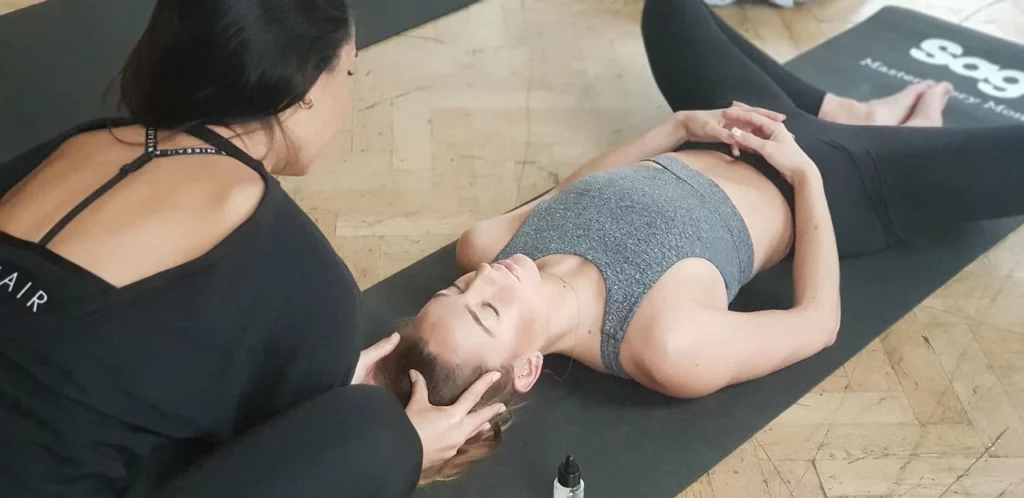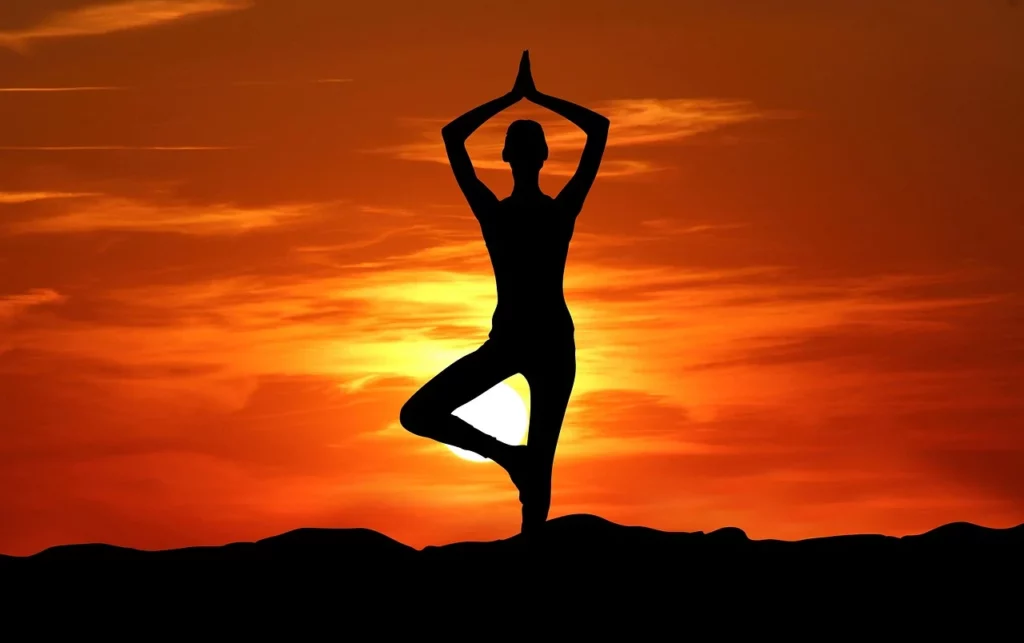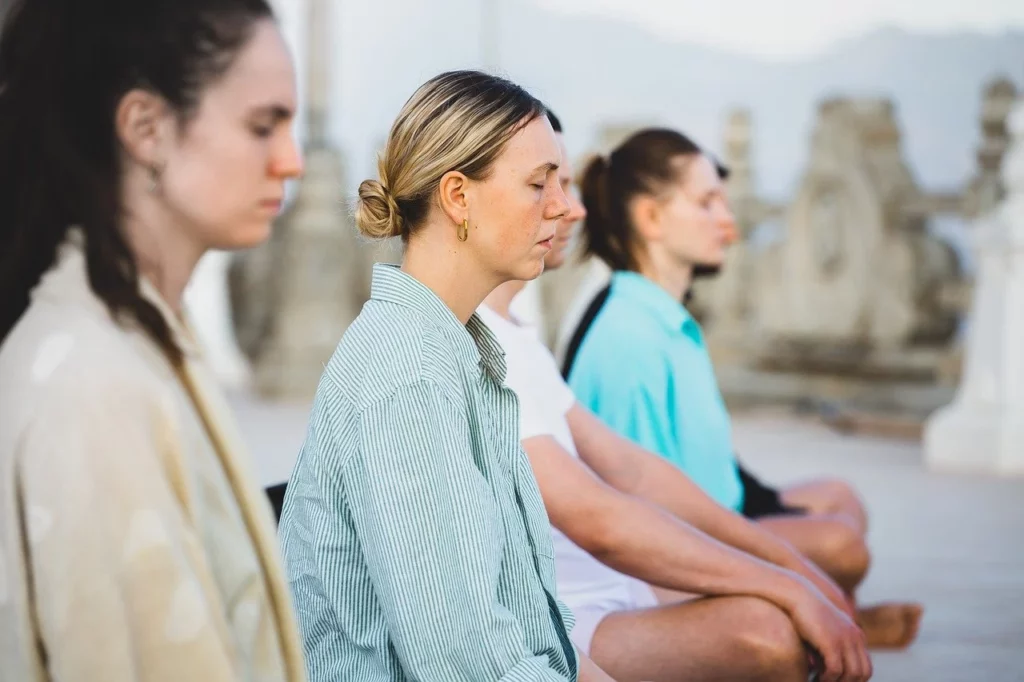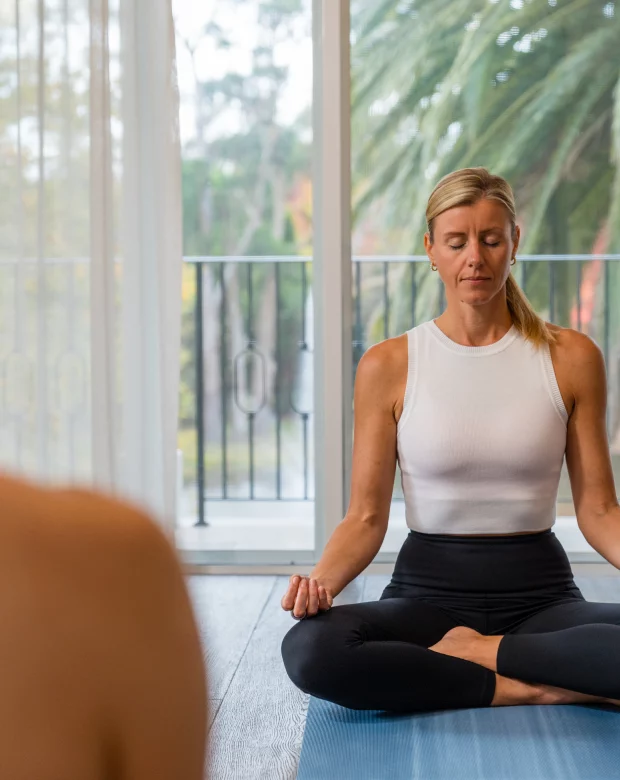In this article we explore somatic healing and trauma-informed yoga at Highlands Recovery, a behaviour medicine institute near Sydney, Australia. We look at how these body-based approaches address the impact of trauma on the autonomic nervous system (ANS) and the brain, the amygdala and prefrontal cortex.
We will talk about how somatic experiencing, developed by Levine, releases stuck energy. We’ll explain how trauma-informed yoga creates a safe space for healing, outline the key principles and specific techniques like Tadasana (mountain pose), Vrksasana (tree pose) and mindful pranayama. And we’ll look at how this fits into Highland’s four phase recovery programme and trauma reprocessing therapies like EMDR (Eye Movement Desensitisation and Reprocessing) and Cognitive Behaviour Therapy, and how the clinical team support self directed health.
Understanding Somatic Healing: A Body-First Approach

Traditional therapies often focus on the cognitive and emotional aspects of healing and sometimes overlook the physical ways in which trauma and chronic stress shows up. Somatic healing focuses on the intricate relationship between mind and body. It recognizes that traumatic experiences get stuck in our physical body creating patterns of tension, restriction and dysregulation. Unlike conventional talk therapy, somatic healing addresses the body as the primary pathway to release held tension and emotional blockages. It acknowledges that trauma can hijack the autonomic nervous system (ANS) and create a cascade of symptoms like chronic anxiety, hypervigilance, digestive issues and fatigue.
Somatic practices like somatic experiencing, body oriented psychotherapy and trauma informed yoga aim to calm the ANS and create a sense of safety, embodiment and self regulation.
The Science of Somatic Healing Experience: How It Works in the Brain
When faced with too much threat or trouble the brain can get overwhelmed and our information processing can grind to a halt. The amygdala, the emotional centre that detects threat, can go into overdrive and we can feel an exaggerated fear response.

Meanwhile the prefrontal cortex, the area that does the reasoning, planning and emotional regulation can shut down and we can’t think straight or make rational decisions. Peter Levine’s somatic experience proposes that trauma creates a “freeze” response in the body and the survival energy never gets discharged. Somatic practices help to release that trapped energy and allow the brain to integrate the traumatic experience. This involves paying attention to bodily sensations – tension, pain, numbness, tingling – so the body can discharge the long held emotional charge. Over time this can help us feel safe, grounded and resilient.
Trauma-Informed Yoga: Creating a Safe Space for Healing

Trauma informed yoga is a compassionate adaptation of traditional yoga practices designed for those who have experienced trauma. It’s about creating a safe, predictable and empowering space where you can make informed choices about your body and movement. Unlike regular yoga classes, trauma informed yoga avoids forced adjustments, rigid alignment cues and hierarchical teacher student dynamics that can trigger feelings of vulnerability or powerlessness. Instead it’s about cultivating interoceptive awareness – listening deeply to the body’s signals – and modifying poses as needed to feel comfortable and in control.
The intention of trauma informed yoga is to help you feel agency, self compassion and reconnection with your body. By offering a gentle non judgemental space to explore and discover yourself, somatic healing and trauma informed yoga can help you reclaim your body as a source of strength, resilience and healing.
Key Principles of Trauma-Informed Yoga
Trauma-informed yoga sets itself apart from regular yoga by prioritizing the unique needs and vulnerabilities of people who have experienced trauma. A few core principles guide this approach, creating a therapeutic environment of safety, empowerment and healing.

- Safety: Creating a safe physical and emotional space is top priority. This goes beyond just making sure the space is hazard free; it’s about clear communication, predictable routines and consistent boundaries. For example, telling participants in advance what to expect in the class, giving clear instructions and getting consent before physical touch. Crucially safety means creating an environment of acceptance and non-judgment where participants can express themselves without fear of criticism or ridicule. A sense of safety can calm the autonomic nervous system into the parasympathetic state of “rest and digest”.
- Choice: Giving participants choices empowers them and helps them regain control that may have been taken away by traumatic experiences. This might mean offering options to modify poses, take breaks at any time or just observe silently without participating. The teacher doesn’t impose specific outcomes or expectations, instead allowing participants to explore their own experience at their own pace. It’s a subtle but powerful shift from being told what to do to being supported in making decisions for their own body and practice.
- Awareness: Encouraging participants to bring mindful awareness to their breath, body sensations and emotions is central to trauma-informed yoga. Interoceptive awareness (awareness of internal bodily sensations) is a skill that can improve autonomic function. This means gentle guidance in noticing the present moment without judgment, observing the ebb and flow of sensations without trying to change them. This practice can help participants reconnect with their body in a positive way, increase their understanding of their internal experience and develop more self-regulation.
- Regulation: Teaching techniques to regulate the nervous system is key. This includes practices such as deep diaphragmatic breathing which stimulates the vagus nerve and calms the nervous system, grounding exercises that connect participants to the present moment and their physical environment, and mindful movement that releases tension and promotes ease. These techniques can help participants manage triggers, reduce anxiety and feel more emotionally balanced.
- Connection: Connection with oneself and others is another principle. This doesn’t mean forced intimacy or group sharing; it means creating opportunities for participants to connect with themselves through self-compassion and self-acceptance and connect with others in a safe and respectful way. This might mean making eye contact (if comfortable), offering words of encouragement or just holding space for each other’s experiences. It’s about building community and belonging while always respecting individual boundaries and needs.
Specific Yoga Techniques for Trauma Release
Some yoga practices are especially good for releasing trauma tension and healing. These work by gently addressing the physical and emotional residue of trauma in the body.
Grounding poses: Poses like Tadasana (mountain pose) and Vrksasana (tree pose) connect you to the earth, to feeling stable, present and embodied. These postures help to counteract the disembodiment and dissociation often associated with trauma. By focusing on the points of contact between your body and the ground you can feel safely anchored in the present moment.

Breathwork (Pranayama): Certain pranayama techniques can be very calming and regulating for the nervous system. Diaphragmatic breathing (also known as belly breathing) involves consciously expanding your abdomen on the inhale and gently contracting it on the exhale, stimulating the vagus nerve and relaxing you. Alternate nostril breathing (Nadi Shodhana) can balance the two sides of the brain, reduce anxiety and bring you into inner harmony. These can be adapted to suit your individual needs and preferences.

Gentle movement: Slow, mindful movement, like Marjaryasana to Bitilasana (cat-cow pose), can release tension, increase body awareness and restore fluidity and ease. These movements are done with attention to the breath and bodily sensations, so you can gently explore your range of motion without pushing beyond your comfort zone. The gentle, rhythmic nature of these movements can be very soothing for the nervous system.

Restorative poses: Poses like supported Balasana (child’s pose) and Savasana (corpse pose) are deep relaxation and allow the body to rest and restore. These are usually held for long periods of time, using props like blankets and bolsters to support your body in a position of complete comfort. Restorative poses engage the parasympathetic nervous system, reducing stress hormones and bringing you into profound calm and well being.

Somatic Healing and Trauma: Addressing the Root Cause
Trauma throws the body’s energy out of whack, causing chronic pain, muscle tension, digestive issues and all sorts of physical and emotional symptoms. Somatic practices release the blockages so energy can flow more freely and deeper healing can happen. By addressing the source of the trauma in the body somatic healing practices can bring more lasting relief from symptoms and more wholeness and well being. Somatic healing can be the catalyst for trauma survivors to be present in the moment and have safety be their new and true response.
Integrating Somatic Healing and Trauma-Informed Yoga Practices into the Recovery Process at Highlands Recovery

At Highlands Recovery, we know that true healing goes beyond just treating symptoms and requires a holistic approach that includes mind, body and spirit. That’s why somatic healing and trauma-informed yoga are woven throughout our 4 phase recovery program alongside individual and group therapy. This is based on behavioral medicine principles.
In Phase 1 (Stabilisation) the body is brought into a state of calm using yoga, somatic massage, healthy eating, sleep hygiene and a safe social environment. In Phase 2 (Trauma Reprocessing) the re-coupling stimulus is addressed using Somatic practices, EMDR, Trauma-focused CBT and/or CPT. In Phase 3 (Integration) clients have weekly individual and group virtual therapy sessions and regular wellbeing check ins which re-integrate day to day stressors and triggers.
The Role of the Clinical Team at Highlands Recovery

Our clinical team, led by Clinical Director Resh, is the foundation of the somatic healing process at Highlands Recovery. Our team includes psychotherapists, exercise physiologists, family doctors, health educators, doctors, nurses, nutritionists, psychiatrists and psychologists. We work with clients using compassionate and curious inquiry to facilitate self-directed health and long term recovery. This collaborative approach, with compassionate and curious inquiry, is the therapeutic relationship that empowers clients and self directed health. Please note admission is subject to clinical assessment and due to the complexity of some conditions we may not be able to treat all clients. We provide world class private and confidential care for all of our clients.
Expected Benefits and What to Expect During a Session

When you’re practicing somatic healing and trauma-informed yoga at Highlands Recovery you can expect to feel reduced anxiety, better sleep, more body awareness, and better emotional regulation. During a session you’ll be guided through gentle movements, breathwork (pranayama) and mindfulness practices that are tailored to you and your comfort level. The therapist will create a safe and supported space for you to listen to your body, respect your boundaries and honour your experience. You may experience different emotions, memories or sensations during a session; the therapist will support you to process these constructively and integrate and heal.
Conclusion
Somatic healing and trauma informed yoga practices is a powerful way to address the deep ingrained effects of trauma on the body and mind. Highlands Recovery offers a holistic approach that prioritises safety, choice, awareness, regulation and connection. Through gentle movement, breathwork and mindfulness clients can release stored energy, rebalance the nervous system and feel more well. Our experienced multidisciplinary team guide clients through this process, self directed health and lasting recovery. At Highlands Recovery we offer a safe space for clients to process trauma and find themselves through our evidenced based behavioural medicine approach.
References
ResearchGate. (n.d.). Field ion microscopy of graphite fibers. Retrieved from https://www.researchgate.net/publication/241614989_Field_Ion_Microscopy_of_Graphite_Fibers
Amazon. (n.d.). The Body Keeps the Score: Brain, Mind, and Body in the Healing of Trauma. Retrieved from https://www.amazon.com/Body-Keeps-Score-Healing-Trauma/dp/0670785938
PubMed. (n.d.). Neural mechanisms of addiction and recovery. Retrieved from https://pubmed.ncbi.nlm.nih.gov/11064015/
PubMed Central (PMC). (n.d.). The impact of trauma on neurobiological processes. Retrieved from https://pmc.ncbi.nlm.nih.gov/articles/PMC4312074/
PubMed Central (PMC). (n.d.). Neuroplasticity in addiction recovery. Retrieved from https://pmc.ncbi.nlm.nih.gov/articles/PMC4278363/
PubMed Central (PMC). (n.d.). Stress and substance use disorders. Retrieved from https://pmc.ncbi.nlm.nih.gov/articles/PMC3082054/
PubMed Central (PMC). (n.d.). Cognitive and emotional processing in trauma survivors. Retrieved from https://pmc.ncbi.nlm.nih.gov/articles/PMC4948497/






















































